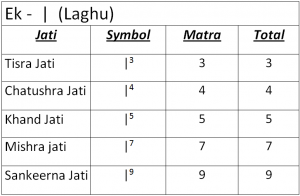Carnatic Taal System / South Indian Taal System
Carnatic Taal System / 35 Taal System is the foundation and most significant part of South Indian Classical Music. We have 7 Tala in south Indian music named – Ek, Rupak, Jhamp, Triput, Dhruv, Matth, Atth. The default matra value of laghu differs as per Tala, but to change the jati of the taal, we change the value of laghu. Which directly affects the total number of beats or matras. In other words, we can say that this change in Laghu forms a new tala. With this method we can transform 7 main tala into 35 talas. This 35 Taal system is the key feature to the Carnatic taal system.
Classification of Jati
Five jaati’s of Laghu – Tisra(3), Chaturasra(4), Khanda(5), Misra(7), and Sankeerna(9); and by incorporating 7 Talas X 5 Jaatis, Which forms a total of 35 Different Talas. For Example, We take Dhruva Tala representing chatushra jaati has 4 2 4 4 ( | O | | ) with one Laghu of Chaturasra Jaati consist of four beat power followed by one Drut of two beats and two Laghus of four beats each. It form a tala with 14 beats in total.Now, When the power of laghu is changed to 3 then, it’s jaati will transform to Tisra Jaati. It transformed as 3 2 3 3 ( | O | | ) 11 Beats Taal. This function is used to change the jaati of the tala which then creates 35 Taals. Here we are describing with the help of charts of all 7 taals showing the change of jati for your reference. This is essential to learn this as it is the base of Carnatic music.
Taals and their Jati transformation Chart
Ek Talam – Natural Value of Laghu is 4.

Rupak Talam – Natural Value of Laghu is 4.
Aadi/Triput Talam – Natural Value of Laghu is 3.
Jhamp Talam – Natural Value of Laghu is 7.
Matya Talam – Natural Value of Laghu is 4.
Dhruv Talam – Natural Value of Laghu is 4.
Ata Talam – Natural Value of Laghu is 5.
Click here To Learn Tabla Online
कर्नाटक ताल पद्धति / ३५ तालों की प्रणाली
कर्नाटिक ताल पद्धति एवं ३५ तालों की प्रणाली, दक्षिण भारतीय संगीत की आधारशिला तथा महत्वपूर्ण अंग है | इस ताल पद्धति में ७ मुख्य तालें है – एक, रूपक, झंप, त्रिपुट, अठ, मंठ, ध्रुव | इसमें लघु की मात्रा संख्या भिन्न-भिन्न है, परन्तु लघु की मात्रा संख्या में बदलाव करके ताल की जाति तथा मात्रा में बदलाव लाया जा सकता है, जोकि ताल की प्रस्तुती पर असर दिखाते हुए नयी ताल का निर्माण करती है | इसी प्रकार ७ तालों से ३५ तालों का निर्माण होता है |
जाति का वर्गीकरण
लघु की ५ जातियां इस प्रकार हैं – तिस्र(३), चतुश्र(४), खंड(५), मिश्र(७) तथा संकीर्ण(९) | उदाहरण स्वरूप, ध्रुव ताल जिसे चतुश्र जाति की ताल माना जाता है की संरचना ४ २ ४ ४ ( | O | | ) है, जिससे १४ मात्रा की ताल की प्राप्ति होती है |
अब यदि हम लघु की संख्या को बदलकर ३ कर दी जाये तो यह ११ मात्राओं की तिस्र जाति ३ २ ३ ३ ( | O | | ) की ताल बन जाएगी | जाति बदलाव के इसी नियम के कारण ३५ तालों की रचना होती है | आईये, अब हम ७ मुख्य तालों की जाति बदलने के क्रम को निम्न चित्रों के माध्यम से समझेंगे |
ताल तथा उनका जातीय प्रारूप
एक तालम – इस ताल में लघु की प्राकृतिक मात्रा ४ है।
रूपक तालम – इस ताल में लघु की प्राकृतिक मात्रा ४ है।
आदि/त्रिपुट तालम – इस ताल में लघु की प्राकृतिक मात्रा ३ है।
झम्प तालम – इस ताल में लघु की प्राकृतिक मात्रा ७ है।
मठ्य तालम – इस ताल में लघु की प्राकृतिक मात्रा ४ है।
अठ तालम – इस ताल में लघु की प्राकृतिक मात्रा ५ है।
ध्रुव तालम – इस ताल में लघु की प्राकृतिक मात्रा ४ है।
In conclusion, with all the above clarification It is clear that the 35 taal system is a key feature of Carnatic music. However, The Raga is also an important aspect but this music style is focusing on the taal system. Therefore, we can say that the change applied to laghu can transform it into a new jati or tala.
Importance Of Taal Taal Database Comparative Study of Taals Tabla Maintenance Tabla Quiz Principle of Formation of Tihai Carnatic Taal System Tabla Apps Tabla Tutorials How To Learn Tabla Online Tabla E-Books Tabla Terminology Concept of Rhythm in Indian Classical Music